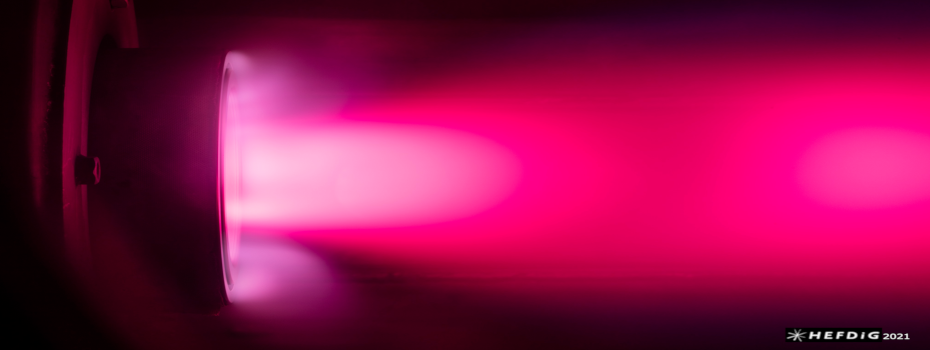Speaker
Description
Ground testing has always been essential for aerospace development. As an example, they are a key component in the design process and qualification of thermal protection materials for re-entry systems. They also have a crucial role to tackle the problem of space debris for which the end-of-life disposal through aerothermal demise in atmospheric entry is largely promoted. In such context, plasma wind tunnels are required for the validation of the design-for-demise (D4D) tools. Their testing conditions (e.g., free-stream enthalpy) must be accurately known to offer flight-relevant test conditions for material testing and precise database generation. Unfortunately, they cannot be directly measured and must rely on empirical formulas or rebuilding procedures. These methodologies couple numerical models and experimental data increasing the total uncertainty of the envisaged quantities due to inaccuracies in the selected models and errors in the measurement chain.
The overall objective of this work is to assess the impact of measurement uncertainties and some model assumptions on the enthalpy inference of Inductively Coupled Plasma facilities through a Bayesian formulation. We have recently presented three different enthalpy rebuilding procedures with application to the VKI’s Plasmatron at the FAR conference held in Heilbronn that is, the ASTM method, the standard VKI rebuilding procedure, and a stochastic approach based on the Bayes theorem. While the former employs an empirical formulation of the enthalpy, function of heat flux and dynamic pressure measurements only, the VKI procedure includes the effect of the catalysis phenomena described by the catalytic coefficient, $\gamma$, assumed known from the literature. Conversely to deterministic approaches resulting in a point-estimate, the stochastic method provides a full probability distribution of the inferred quantity due to measurements’ uncertainties and models’ inaccuracies. A normal distribution with a 2$\sigma$ confidence level set to 10% uncertainty range for the experimental data and a (log) uniform distribution for $\gamma$ was considered based on the conclusions of previous works. This paper aims to extend the previous results by computing the actual uncertainties of the experimental data, and to investigate other models’ assumptions hereafter presented.
The Bayesian formulation requires the solution of the forward problem thousands of times to correctly predict the statistics of the quantity of interest. The forward problem is based on the heat flux computation that is then compared with the experimental counterpart through the evaluation of the likelihood function. The heat flux computation is performed with two CFD codes that are, the ICP solver and the Boundary Layer (BL) code. The former simulates the plasma jet in the Plasmatron chamber under the LTE assumption. The ICP reference conditions are the mass flow rate supplied to the torch, $\dot{m}$, the static pressure of chamber, $p_s$, and the effective power supplied to the plasma by induction. For low subsonic, low Mach number test conditions, $\dot{m}$ and $p_s$ are considered constant, as verified by the results of numerical simulations and dynamic pressure measurements, and therefore set equal to the experimental values. As far as $P^{eff}_{el}$ is concerned, it is exact value is still unknown and efforts are underway to overcome the problem. Today, a power efficiency $ \eta = \frac{P^{eff}_{el}}{P^{eff}_{el}}$ = 50 % is accounted for with $P_{el}$ the electrical power supplied by the VKI’s Plasmatron generator to the coil. The ICP provides the boundary layer edge quantities, in terms of five non-dimensional parameters, to the BL code that solves the flow around the testing sample, with catalytic coefficient $\gamma$, under chemical non-equilibrium conditions. One of the outputs of the BL code is the heat flux at the wall.
This paper proposes to investigate the assumptions of $\eta$ = 50% and the definition of the non-dimensional parameters in enthalpy inference. For instance, the fifth parameter is defined as the ratio of the normal component of the velocity with respect to the probe at the boundary layer edge dimensionalized by the free-stream velocity. However, the choice of the free stream point may differ among the authors (e.g., half at the distance between the probe and the torch exit section or the point where the velocity gradient of the tangential component along the tangential direction has an inflection point, etc). Preliminary studies have shown a negligible effect on the heat flux estimation, but further investigations are necessary to better assess the role in the inference problem. Furthermore, the chemical non-equilibrium in the boundary layer employs chemical models such as Park’s Gupta’s or Dunn-Kang’s, that provide the coefficients of the Arrhenius law modeling the formation/deprecation of the species which may significantly impact the heat flux computation. Such coefficients are affected by significant inaccuracies being calibrated more than 20 years ago and validated with experimental data available at that time. We, therefore, propose to extend the stochastic approach to study the Park’s coefficients uncertainties in the enthalpy estimation.
Summary
The Bayesian formulation of the enthalpy rebuilding in Inductively Coupled Plasma facility is here presented with application to the VKI's Plasmatron. The procedure compares experimental data and its numerical counterparts through the evaluation of the likelihood function. The paper focuses on the role played by measurement uncertainties and some model assumptions in the inference of the quantity of interest.

